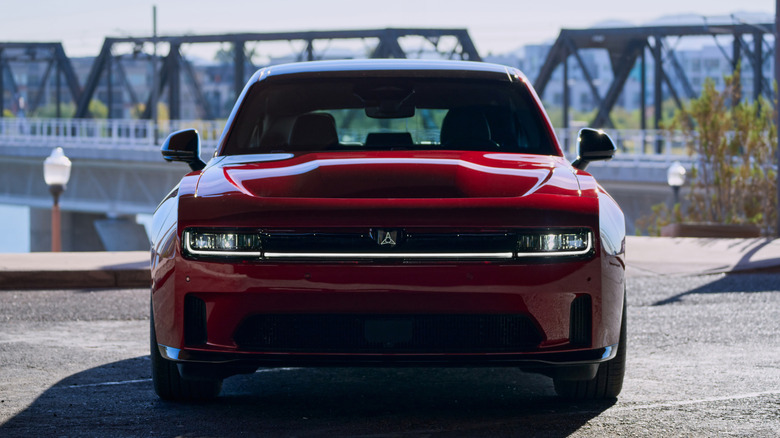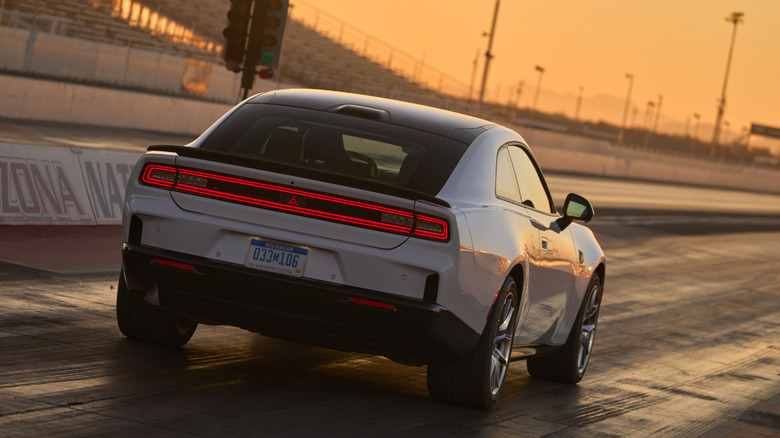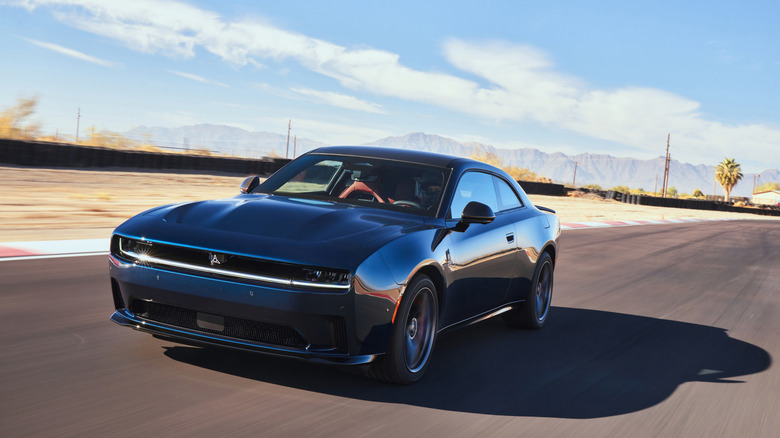Is Dodge Reviving The V8 HEMI For The Charger? Here's What We Know
Dodge's latest shift towards EV technology marked one of the most divisive periods of the company's history, with the automaker discontinuing the iconic Hemi engine that once featured in its muscle cars and Ram trucks. But in March 2025, rumors began to indicate the return of the Hemi-powered Charger in late 2026. This news came during troubling economic times for most American carmakers, including Stellantis, which has been among the worst hit by President Trump's tariffs. But it's undoubtedly also a welcome one, as long-time enthusiasts openly criticized the phasing out of the Hemi throughout various model lines back when it was initially announced.
Debuting in 2024, the modern Dodge Charger Daytona was originally designed primarily as an EV, specifically as the first "EV muscle car" ever produced. It represented Dodge's push toward sustainability, a perspective headed by former Stellantis CEO Carlos Tavares. His resignation in December 2024 occurred during a period of financial and executive flux within Stellantis, which saw its shares and stocks plummet in just one fiscal year. In addition, Dodge CEO Tim Kuniskis also resigned before migrating to Ram after a short hiatus; Kuniskis is known as the "Godfather of the Hellcat," a sign that bodes well for future Hemi trucks.
As for the Charger, while it may receive the Hemi in late 2026, there is no official word as to which specific model will get the engine. Let's explore what we know, as well as discuss Stellantis and Dodge's economic situation and how that might affect the Charger.
Setting the stage for the Charger's redesign
Put simply, the Charger platform was designed to accommodate two different powertrains: electric motors or a turbocharged straight-six in the Charger Sixpack, which itself didn't arrive until model year 2025. However, incorporating multiple powertrain options was always the plan, according to a spokesperson responding to a Car and Driver article about the Charger Daytona: "Multi-energy options have always been a part of the plan. The two-door Dodge Charger Daytona R/T and Charger Daytona Scat Pack ... are in dealerships now, with four-door Charger Daytona models set to join them soon."
Considering the current Charger's power figures of up to 670 horsepower, it seems likely that the Hemi-powered variant will push equally respectable figures. However, there's no official word on which Hemi variant Stellantis will install and whether it'll be naturally aspirated or supercharged. For all we know, it could be an entirely new configuration as well — we'll likely find out in 2026. That delay is likely part of the redesign process, as Dodge might not have planned for the Charger Daytona to accommodate the Hemi in the first place.
Modern Hemi engines have traditionally been built in Stellantis' Saltillo plant in Mexico. However, the company underwent a dramatic shift in production facilities in February 2025, with leaks stating that Stellantis would move Hemi production to Dundee, Michigan. That's certainly good news for Hemi Charger fans — with stateside output of the 5.7, 6.4, and 6.2-liter supercharged Hemi models allegedly restarting in August 2025, it appears that all systems are green for the Hemi Charger's return.
The economics behind the Hemi's comeback
As a quick refresher, President Trump's tariffs placed a 25% import tax on all goods from Mexico and Canada to kickstart domestic production. This directly led to skyrocketing prices across the industry, which eventually caused Trump to walk back and reduce various tariffs for automakers. However, his tariffs remain in effect for various automotive parts, meaning prices for maintaining new cars are likely to remain costly. Meanwhile, Stellantis shares and stocks fell by as much as 33% between February 2024 and May 2025, reaching lows not seen since 2016, excluding the pandemic.
Stellantis witnessed an internal shake-up in the midst of all of this, with key staff either resigning or transferring marques amid the turmoil. This effectively places the company in a precarious financial position as of May 2025. But it's one that they can recover from if they play their cards right. And one major ace they have is the Hemi.
The Hemi has a large, dedicated fan base and a reputation for speed and performance dating back to 1951. Today, it features in everything from road cars and trucks to top-fuel dragsters producing over 10,000 horsepower. The modern Charger, meanwhile, has received a mixed reception; by many accounts, it's actually quite a nice muscle car from a rational standpoint. But nobody bought a Hellcat because it was a rational decision. You buy a Hemi-powered Hellcat for the supercharger whine, the burnouts, and the ludicrous levels of insanity it offers. Combining that with the new Charger may be a winning move here, though only time will tell.


